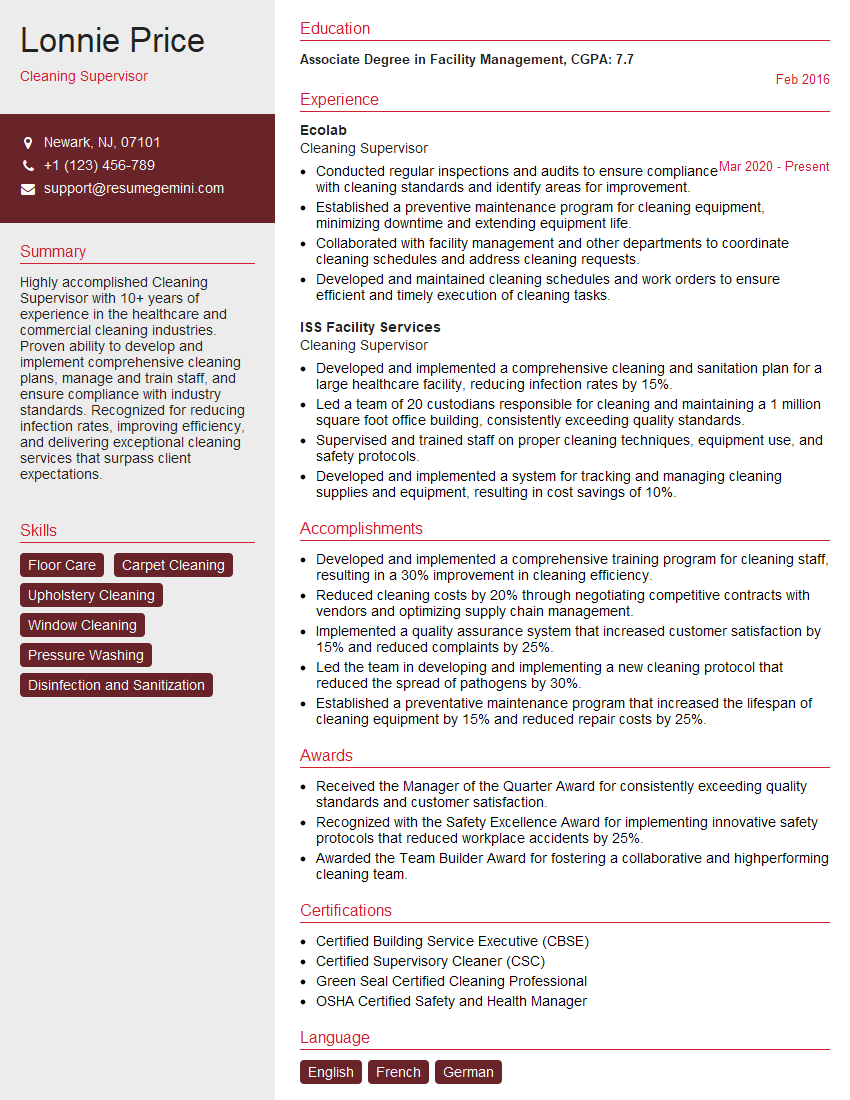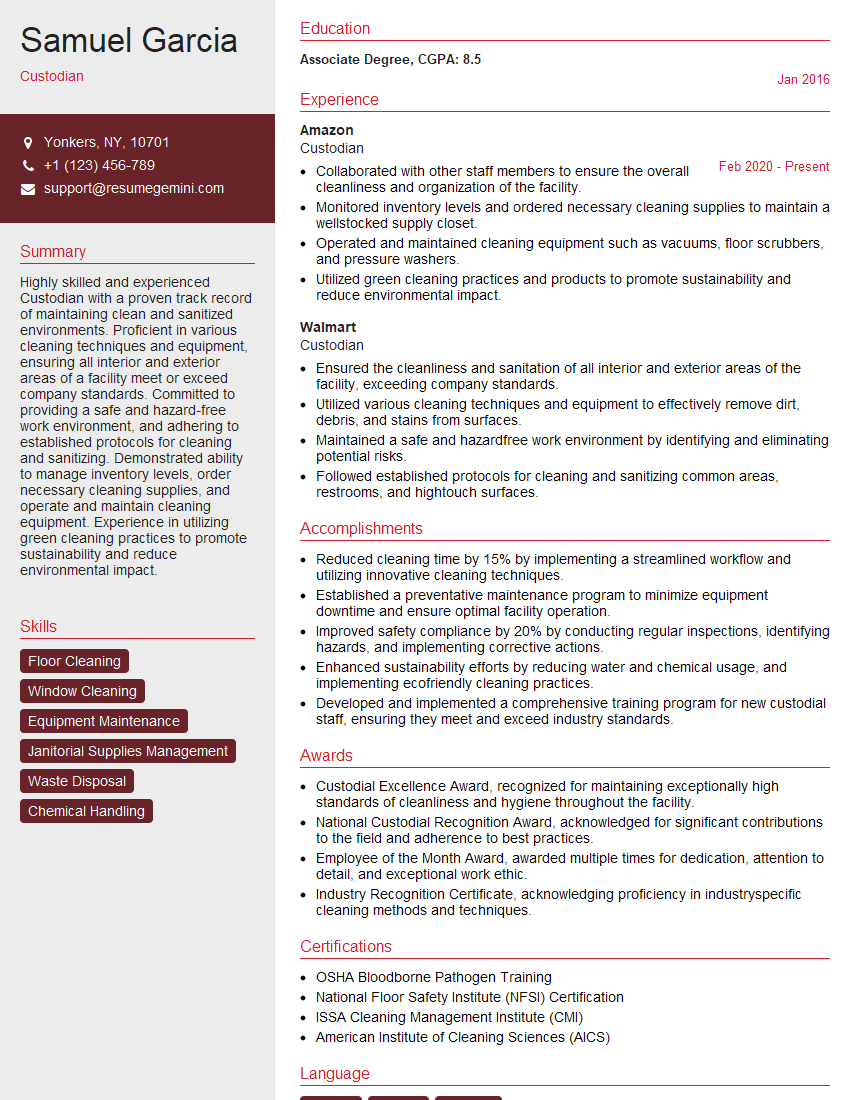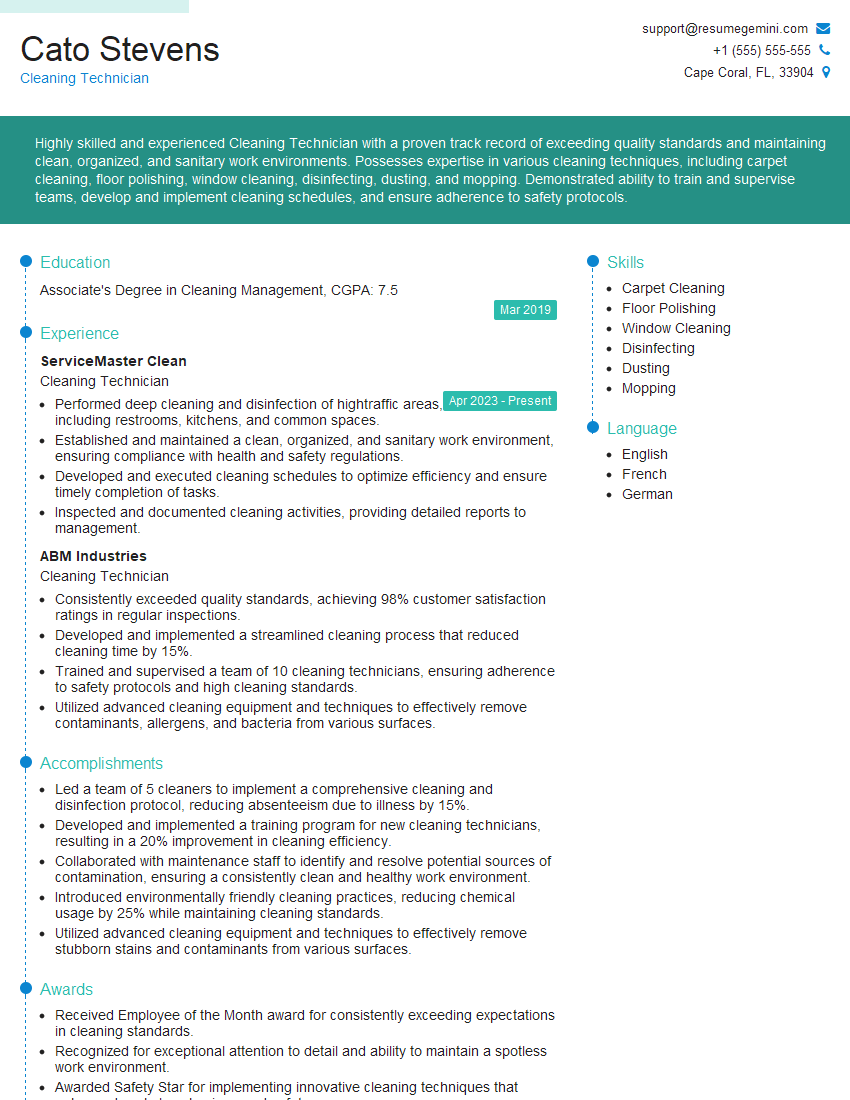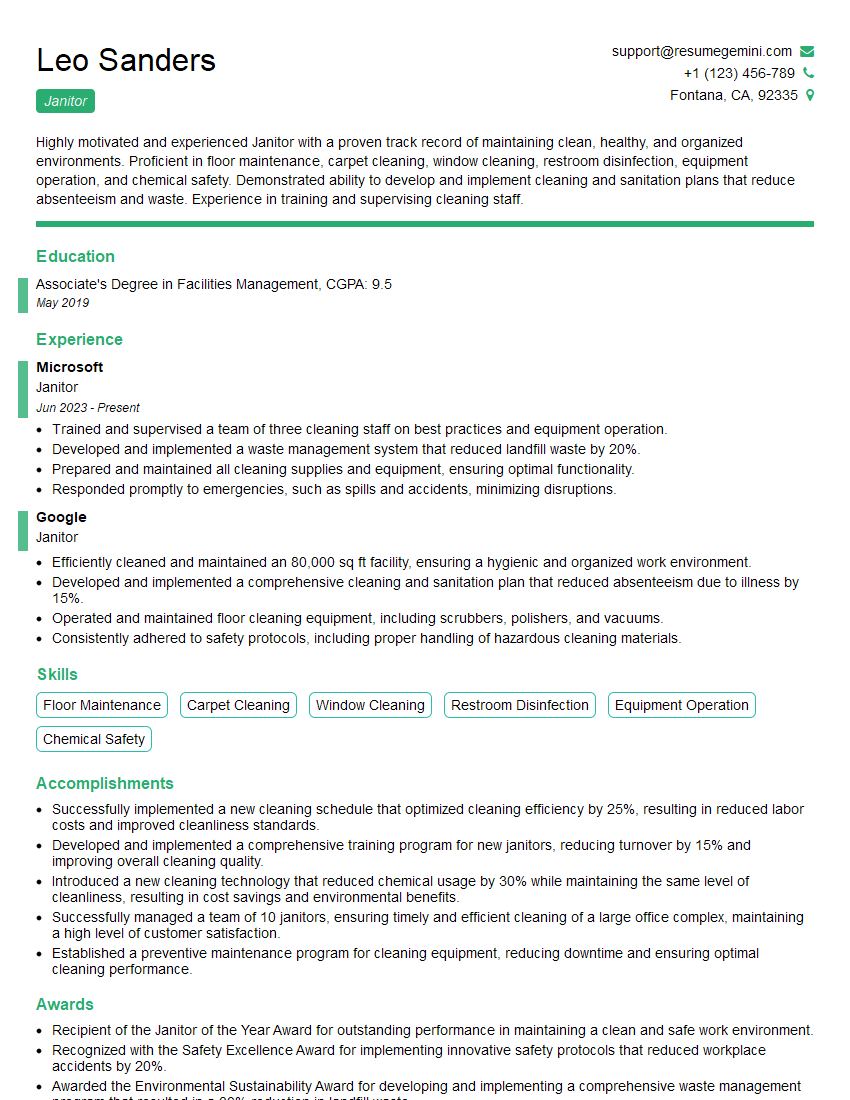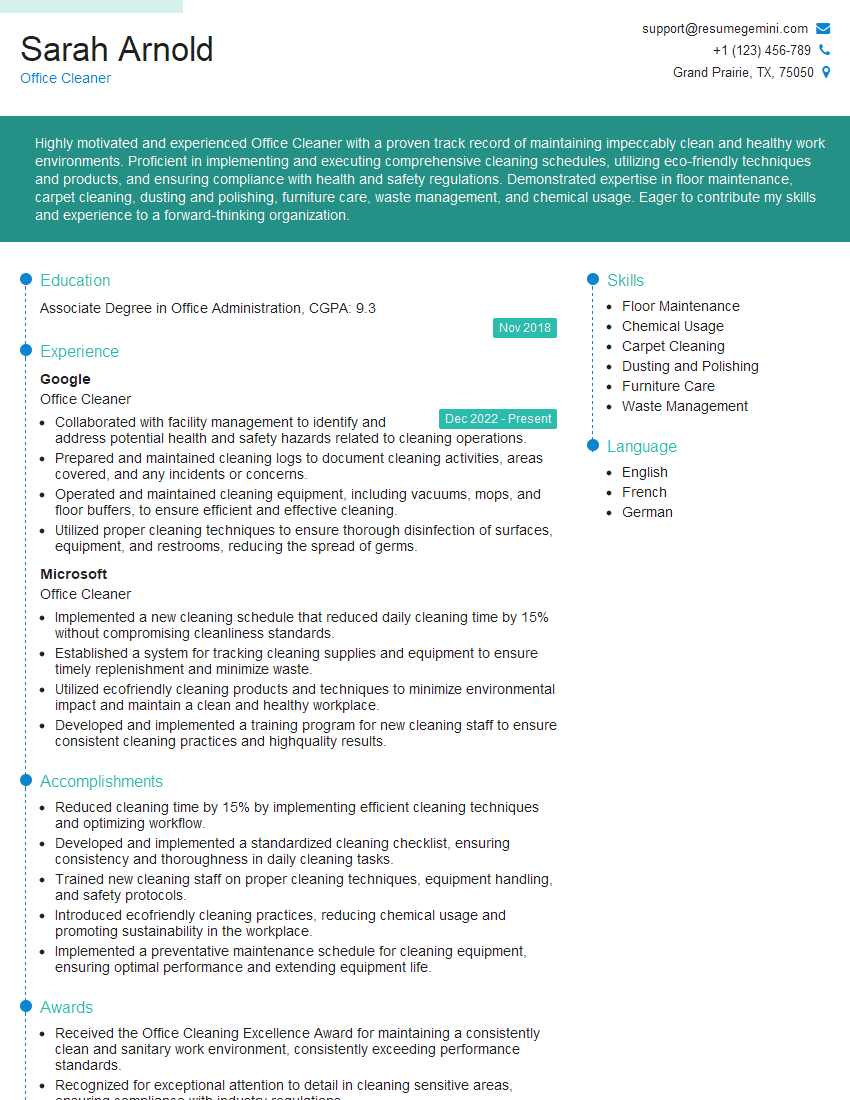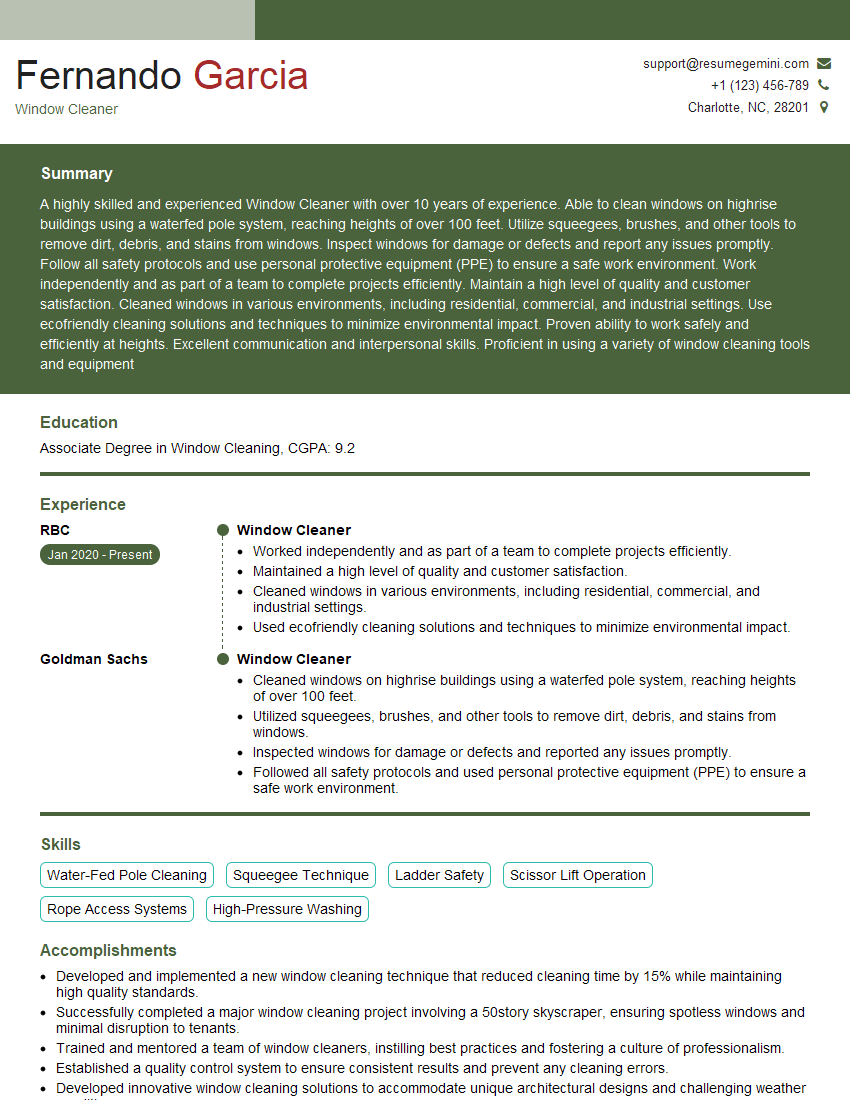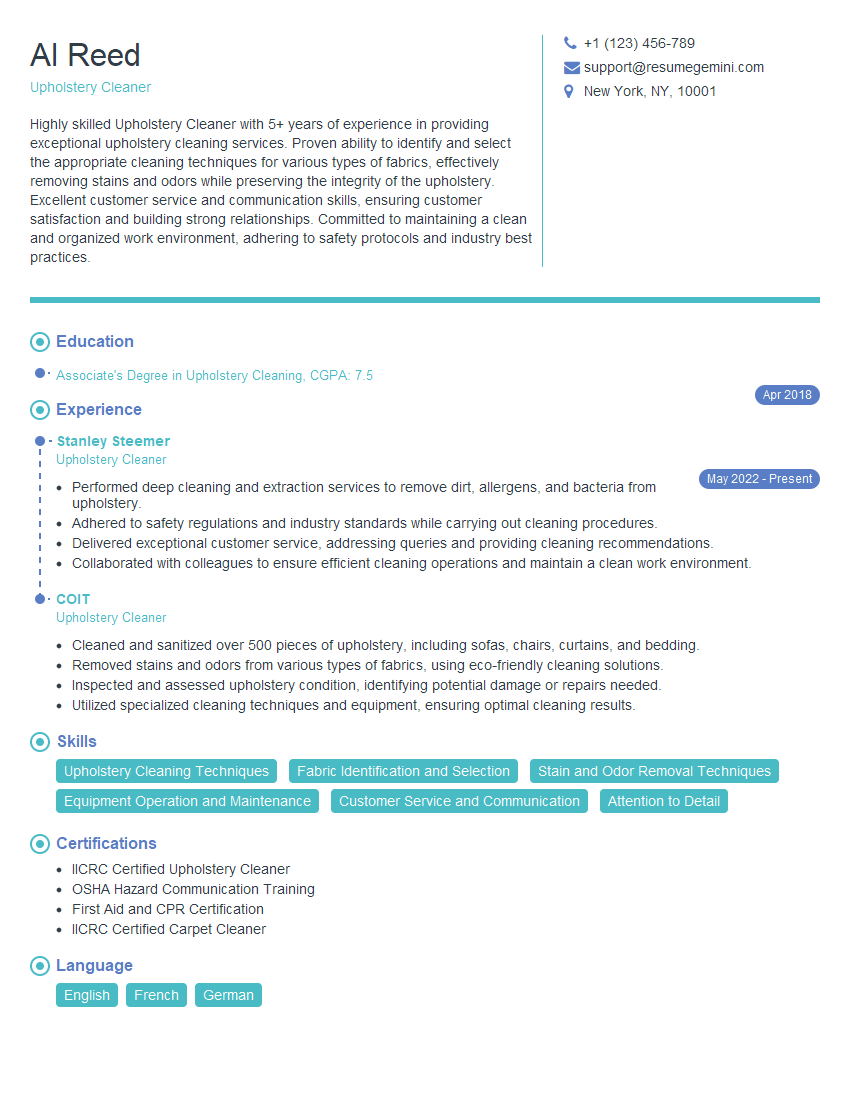Interviews are opportunities to demonstrate your expertise, and this guide is here to help you shine. Explore the essential Interior Cleaning interview questions that employers frequently ask, paired with strategies for crafting responses that set you apart from the competition.
Questions Asked in Interior Cleaning Interview
Q 1. Describe your experience with different cleaning agents and their appropriate uses.
My experience with cleaning agents is extensive, encompassing a wide range of products tailored to different surfaces and soiling types. Understanding the chemical composition and appropriate application is crucial for effective and safe cleaning. For instance, I utilize all-purpose cleaners for everyday grime on most surfaces, but know to avoid them on delicate materials like polished wood or certain fabrics. For tougher stains, I rely on specialized products. Degreasers are invaluable for kitchen appliances and heavily soiled areas, while disinfectants are essential for bathrooms and high-touch surfaces, ensuring a hygienic environment. For hardwood floors, I prefer pH-neutral cleaners to avoid damage. Carpet cleaning often involves enzymatic cleaners to break down organic stains, and specialized solutions for specific stains like red wine or pet accidents. I always follow the manufacturer’s instructions carefully, paying close attention to dilution ratios and safety precautions. Choosing the right cleaning agent is like selecting the right tool for a job – using the wrong one can be ineffective or even damaging.
- All-purpose cleaners: Ideal for general cleaning of most hard surfaces.
- Degreasers: Effective for removing grease and oil from kitchen surfaces.
- Disinfectants: Crucial for eliminating bacteria and viruses from high-touch surfaces.
- pH-neutral cleaners: Safe for use on hardwood floors and other delicate surfaces.
- Enzymatic cleaners: Designed to break down organic stains in carpets and upholstery.
Q 2. What safety procedures do you follow when handling cleaning chemicals?
Safety is paramount when handling cleaning chemicals. I always prioritize the following: First, I meticulously read and follow the manufacturer’s instructions on each product. This includes understanding dilution ratios, application methods, and any specific precautions. Second, I always wear appropriate personal protective equipment (PPE), including gloves, eye protection, and sometimes a respirator, especially when working with strong chemicals or in poorly ventilated areas. Third, I ensure adequate ventilation by opening windows or using exhaust fans to minimize exposure to fumes. Fourth, I store chemicals securely, away from children and pets, following all label instructions for storage. Fifth, I never mix different cleaning chemicals, as this can create dangerous reactions. Finally, I dispose of used chemicals responsibly, adhering to local regulations. One time I had a minor incident involving a slight skin irritation, which reminded me how crucial consistent safety measures are. This reinforced the importance of wearing gloves even when using seemingly mild products. Safety isn’t just a rule; it’s a habit, and it prevents potential health hazards and accidents.
Q 3. Explain your method for cleaning various floor types (e.g., hardwood, tile, carpet).
My approach to cleaning different floor types is tailored to their specific characteristics. For hardwood floors, I start by sweeping or vacuuming to remove loose debris. Then, I use a pH-neutral cleaner diluted according to manufacturer instructions, applying it with a damp mop, ensuring I don’t oversaturate the wood. I always rinse thoroughly to avoid residue buildup. For tile floors, I use a similar approach, but might use a slightly stronger cleaner for tougher stains, paying attention to grout lines which require more scrubbing. For carpet cleaning, I often use a professional-grade carpet cleaner, pre-treating stains as needed with enzyme-based solutions. I follow the machine’s instructions carefully, ensuring thorough rinsing and allowing adequate drying time. The key is to understand the specific needs of each surface – avoiding harsh chemicals on hardwood, for instance, and targeting grout lines when cleaning tile. Different floors require different tools and techniques, and knowing the best method minimizes damage and maximizes cleaning effectiveness.
Q 4. How do you prioritize tasks when cleaning a large space?
When cleaning a large space, a systematic approach is essential. I generally prioritize tasks based on their urgency and impact. I typically begin with a quick overview to assess the space and identify high-priority areas, like high-traffic zones or visibly soiled spots. Then, I move from top to bottom, starting with dusting high surfaces (ceilings, light fixtures, shelves) and working my way down to lower surfaces (furniture, floors). This prevents dust from settling back onto already cleaned areas. I also prioritize areas with potentially more sensitive surfaces or those needing longer drying times. I divide the space into manageable sections, focusing on completing one area before moving on to the next. This method ensures thorough cleaning and prevents overlooking specific tasks. My goal is efficiency without sacrificing quality. For instance, in an office, I’d prioritize common areas, conference rooms and workstations before tackling individual desks, ensuring the most-used areas are spotless first.
Q 5. What is your experience with operating cleaning equipment (e.g., vacuums, floor buffers)?
I’m proficient in operating a variety of cleaning equipment. My experience includes using upright and canister vacuums for various floor types, adjusting suction and attachments as needed. I’m skilled with floor buffers, understanding the importance of using the correct pads and maintaining the proper speed to avoid damaging surfaces. I’m also familiar with using steam cleaners for disinfecting and deep cleaning, and carpet extractors for tackling stubborn stains and allergens in carpets and upholstery. Regular maintenance and understanding the specific features of each machine are essential to prolong their lifespan and ensure optimal cleaning performance. Improper use can damage equipment or even create safety hazards, thus knowledge of each machine’s capabilities is crucial.
Q 6. Describe your experience with maintaining inventory of cleaning supplies.
Maintaining accurate inventory of cleaning supplies is vital for efficient operations. I use a combination of methods to track supplies. I typically create a spreadsheet or utilize a dedicated inventory management system, listing each item, its quantity, and reorder point. This allows me to monitor stock levels and anticipate when reordering is necessary. I regularly check stock levels, physically counting items and updating the inventory. I also incorporate a system for tracking consumption rates, which helps predict future needs and avoid running out of essential supplies during a job. This not only ensures I have the necessary materials, but it also helps control costs and prevents unnecessary purchases. A well-maintained inventory minimizes interruptions to my work and ensures consistent cleaning quality.
Q 7. How do you handle unexpected challenges or messes during a cleaning job?
Handling unexpected challenges is a key aspect of professional cleaning. I approach unexpected messes or problems systematically. First, I assess the situation, identifying the nature and extent of the problem. Then, I determine the best course of action, selecting the appropriate cleaning agents and equipment. If it’s a spill, for example, I’ll focus on immediate containment to prevent it from spreading. For unfamiliar stains, I’ll test a cleaning solution in an inconspicuous area first to avoid damage. If the problem exceeds my capabilities, I won’t hesitate to contact the client or supervisor for guidance or assistance. For example, I once encountered a significant water leak during a cleaning job. I quickly assessed the situation, contained the water to prevent further damage, and immediately contacted the client to inform them and suggest next steps. Problem-solving requires a mix of resourcefulness, decisiveness and clear communication.
Q 8. How familiar are you with different disinfection techniques and protocols?
Disinfection techniques are crucial for eliminating harmful microorganisms. My familiarity spans various methods, from using EPA-registered disinfectants effective against specific pathogens like Staphylococcus aureus (common bacteria) and Influenza A virus (influenza), to understanding the importance of contact time and proper dilution ratios. I’m adept at applying different techniques based on the surface type and level of contamination. For instance, a hospital setting requires more stringent protocols than a typical office.
- Chemical Disinfection: This involves using disinfectants like bleach solutions (following proper dilution guidelines), quaternary ammonium compounds, and hydrogen peroxide. I strictly adhere to safety data sheets (SDS) for each product.
- Electrostatic Spraying: This advanced technique utilizes a charged mist that coats surfaces evenly, ensuring thorough disinfection, particularly in hard-to-reach areas. I have experience using this method for large-scale disinfecting.
- UV-C Light Disinfection: I’m knowledgeable about the use of UV-C light to eliminate pathogens on surfaces. This method is particularly effective in complementing chemical disinfection. However, it requires careful application to ensure safety.
- Following protocols: I am well-versed in following protocols like those provided by the CDC, OSHA, and other relevant organizations. This includes proper PPE (Personal Protective Equipment) usage, waste disposal, and documentation of cleaning and disinfection processes.
Understanding the specific needs and potential risks associated with each technique and always prioritizing safety is critical. My experience ensures I choose and implement the most suitable and effective disinfection approach for each job.
Q 9. What is your approach to cleaning delicate surfaces (e.g., antiques, electronics)?
Cleaning delicate surfaces requires a gentle yet effective approach. I prioritize minimizing risk of damage by using specialized cleaning products and techniques for each material. My process is always customized to the specific item.
- Assessment: Before starting, I carefully assess the surface, identifying the material (wood, metal, fabric, etc.) and any pre-existing damage. This helps me choose appropriate cleaning agents and tools.
- Testing: I always perform a spot test in an inconspicuous area to check the cleaning solution’s reaction before applying it to the entire surface. This prevents unforeseen damage.
- Gentle Cleaning: I use soft, lint-free cloths, microfiber cloths, or specialized brushes suitable for the material. I avoid abrasive cleaners and harsh scrubbing to prevent scratching or dulling. For electronics, I use only damp, not soaking wet, cloths and always unplug the devices before cleaning.
- Specialized Products: I use pH-neutral cleaners or specialized products designed for antiques or electronics. For example, I might use a wood cleaner specifically formulated for polishing antique furniture, or a screen cleaner for delicate electronics.
For instance, when cleaning an antique grandfather clock, I’d start by dusting it gently with a soft brush, then carefully wipe down the surfaces with a damp cloth using a specialized wood cleaner, taking extra care with intricate carvings. Similarly, when cleaning electronics, I’d utilize compressed air to clean out dust from vents and ports before gently wiping screens with an appropriate cleaning solution and a microfiber cloth.
Q 10. How do you ensure the safety and security of the premises while cleaning?
Ensuring the safety and security of the premises is paramount. My approach involves several key steps.
- Access Control: I always use secure access methods provided by clients – keypads, keycards, or direct supervision by building management.
- Security Checks: Before starting and after finishing, I perform a quick security check of doors and windows, ensuring they are properly secured. I report any unusual findings immediately to the client.
- Valuables: If handling valuable items during cleaning, I take extra precautions, such as keeping them in sight, and if necessary, taking photos for documentation.
- Personal Safety: I always wear appropriate Personal Protective Equipment (PPE), including gloves, eye protection, and potentially respirators depending on the cleaning task. I’m mindful of potential hazards such as wet floors and electrical equipment, and always use safety equipment as needed.
- Incident Reporting: I immediately report any accidents, damage to property, or security breaches to the client or building manager.
For example, in a residential cleaning, I’d always ensure all doors and windows are locked when leaving the property, and report anything out of the ordinary, such as a broken window or a damaged door. In an office building, I would adhere strictly to the building’s security protocols and sign in/out properly.
Q 11. How do you effectively manage your time and meet deadlines?
Effective time management is essential. I utilize several strategies to meet deadlines.
- Detailed Planning: Before each cleaning job, I create a detailed plan, breaking down tasks into smaller, manageable steps. This allows for efficient allocation of time.
- Prioritization: I prioritize tasks based on urgency and importance, ensuring that critical tasks are completed first.
- Time Tracking: I use time-tracking methods to monitor my progress and identify areas where I can improve efficiency. This data helps refine my future cleaning plans.
- Organization: I maintain an organized work environment to minimize time wasted searching for supplies or equipment.
- Communication: I maintain clear communication with clients regarding the cleaning schedule and any potential delays.
For example, in a large office cleaning, I’d prioritize high-traffic areas and restrooms first, then move onto less critical spaces. I’d also use a checklist to ensure that I haven’t missed any tasks and stick to a planned schedule.
Q 12. Explain your experience working independently and as part of a team.
I’ve successfully worked both independently and as part of a team. My experience demonstrates adaptability and strong collaborative skills.
- Independent Work: When working independently, I am self-motivated and capable of managing my own workload efficiently. I’m meticulous in my work and pay close attention to detail, ensuring high-quality results.
- Teamwork: In team settings, I am a collaborative team member who communicates effectively and readily shares knowledge and experience with colleagues. I can adapt to different team dynamics and contribute positively to the overall team effort. I’m adept at delegating tasks efficiently and supporting other team members where needed.
For instance, while working independently on residential cleaning, I was able to manage my schedule effectively, arriving on time and completing the job efficiently. When part of a larger cleaning crew in a post-construction cleanup, I worked with the team to efficiently partition the work based on individual strengths.
Q 13. How do you handle difficult or demanding clients or supervisors?
Handling difficult clients or supervisors requires patience, professionalism, and effective communication. My approach prioritizes finding solutions and maintaining a positive working relationship.
- Active Listening: I actively listen to their concerns and try to understand their perspective. I ask clarifying questions to ensure a full understanding of the issue.
- Empathy: I show empathy and understanding towards their concerns, even if I disagree with their perspective. A calm and respectful demeanor helps diffuse difficult situations.
- Problem-solving: I proactively look for solutions that address both the client’s needs and my capabilities. I offer reasonable compromises and alternatives when possible.
- Documentation: In situations that require it, I carefully document all communications and agreements. This creates a clear record of events and mitigates misunderstandings.
For example, if a client has an unreasonable expectation, I would calmly explain the limitations and propose an alternative solution that meets their needs as much as possible without compromising the quality of the service or my safety standards. If a supervisor is demanding, I’d actively communicate challenges and work with them to find the best approach to meet the task’s requirements and maintain a positive professional relationship.
Q 14. Describe your experience with post-construction cleaning.
Post-construction cleaning requires a different skill set than regular cleaning. My experience includes comprehensive cleanup involving significant debris removal and detailed finishing.
- Debris Removal: This involves removing large amounts of construction debris, such as wood scraps, drywall dust, and other construction materials. This often requires specialized equipment and efficient waste disposal strategies.
- Specialized Cleaning: Cleaning involves the removal of paint splatters, adhesive residue, and other difficult-to-remove substances. This often requires the use of specialized cleaning agents and equipment.
- Deep Cleaning: Post-construction cleaning requires a thorough deep cleaning of all surfaces, including floors, walls, and ceilings, to remove fine dust and debris.
- Safety: This type of cleaning involves navigating potentially hazardous situations, like exposed wiring or uneven flooring. Adherence to safety protocols is critical.
- Waste Management: Proper handling and disposal of construction waste, including compliance with local regulations, are crucial.
In one project, I supervised a team in the cleaning of a newly constructed office building. We tackled the cleanup in phases, starting with large debris removal using heavy machinery and followed by specialized cleaning techniques to remove paint splatters and adhesive residue. Finishing involved deep cleaning of all surfaces, ensuring everything was spotless and ready for occupancy.
Q 15. What are your strategies for preventing the spread of germs and bacteria?
Preventing the spread of germs and bacteria is paramount in interior cleaning. My strategy is multifaceted and focuses on a combination of thorough cleaning, disinfection, and proper hygiene practices. Think of it like building a strong defense against an invading army!
Thorough Cleaning: This is the first line of defense. I use appropriate cleaning agents and tools to remove visible dirt, dust, and organic matter. This reduces the overall bacterial load. For example, I’ll vacuum carpets thoroughly before using a disinfectant to remove the majority of dust mites and other allergens first.
Disinfection: After cleaning, I use EPA-registered disinfectants to kill remaining bacteria and viruses. This is crucial for high-touch surfaces like doorknobs, light switches, and countertops. I always follow the product instructions carefully to ensure effectiveness and safety.
Hygiene Practices: I always wear clean gloves and change them frequently. I use separate cleaning cloths and tools for different areas to prevent cross-contamination. Proper handwashing is essential before and after each cleaning task.
Personal Protective Equipment (PPE): For specific situations such as biohazard cleanup (discussed later), I employ additional PPE like masks, eye protection, and protective suits.
Career Expert Tips:
- Ace those interviews! Prepare effectively by reviewing the Top 50 Most Common Interview Questions on ResumeGemini.
- Navigate your job search with confidence! Explore a wide range of Career Tips on ResumeGemini. Learn about common challenges and recommendations to overcome them.
- Craft the perfect resume! Master the Art of Resume Writing with ResumeGemini’s guide. Showcase your unique qualifications and achievements effectively.
- Don’t miss out on holiday savings! Build your dream resume with ResumeGemini’s ATS optimized templates.
Q 16. How do you deal with stains on various surfaces (e.g., carpet, upholstery)?
Stain removal depends heavily on the type of stain, the surface material, and the stain’s age. It’s a bit like solving a detective mystery – you need to identify the culprit before you can neutralize it.
Carpet Stains: I assess the stain (is it oil-based, water-based, etc.?), blot (never rub!) to remove excess, and then apply a suitable stain remover. For example, a commercial carpet cleaner might be ideal for a red wine spill, but a simple solution of water and mild detergent might suffice for a minor dirt mark. Always test any cleaning solution on an inconspicuous area first.
Upholstery Stains: Similar to carpets, upholstery requires a gentle approach. I pre-test cleaning solutions and work from the outside of the stain inwards. Different fabrics require different cleaning methods – delicate fabrics may require professional dry cleaning.
Other Surfaces: Hard surfaces (tiles, countertops) are often easier to clean. I usually start with warm soapy water and then use a specialized cleaner for stubborn stains.
If a stain is particularly stubborn or I’m unsure of the best approach, I might recommend professional stain removal services.
Q 17. What’s your process for dealing with biohazard cleanup?
Biohazard cleanup requires specialized knowledge, training, and equipment. It’s not something to take lightly; it requires careful handling to protect both the environment and the people involved. Think of it as a high-security operation requiring precision and expertise.
Safety First: I always use appropriate PPE, including respirators, gloves, and protective suits. This protects me from exposure to hazardous materials.
Containment: I carefully contain the affected area to prevent the spread of contamination.
Decontamination: I use EPA-registered disinfectants and specialized cleaning solutions to thoroughly decontaminate the affected area, following all safety regulations and protocols.
Disposal: Contaminated materials are disposed of according to local and federal regulations. This is often handled by specialized waste disposal companies.
Documentation: I meticulously document the entire process, including the cleaning methods used and the disposal of waste materials.
It’s important to note: I only undertake biohazard cleanup if I have the appropriate training and certification. Otherwise, I would always recommend contacting a qualified biohazard remediation company.
Q 18. Describe your understanding of green cleaning practices.
Green cleaning focuses on using environmentally friendly products and methods to minimize the impact on human health and the environment. It’s about being kind to our planet while still achieving a spotless clean. Think of it as a sustainable approach to cleanliness.
Eco-Friendly Products: I use cleaning products that are biodegradable, non-toxic, and made with plant-based ingredients. I avoid harsh chemicals and phosphates whenever possible.
Reusable Materials: I opt for reusable microfiber cloths and mops instead of disposable ones, reducing waste.
Water Conservation: I use water efficiently, using appropriate quantities and avoiding unnecessary rinsing.
Energy Efficiency: I use energy-efficient cleaning equipment, if possible.
In many cases, green cleaning solutions are just as effective as traditional ones, if not more so.
Q 19. What methods do you use to prevent re-soiling of cleaned surfaces?
Preventing re-soiling is crucial for maintaining a clean environment. Imagine building a house – you wouldn’t want to build it only to have it immediately fall apart! This requires a proactive approach.
Thorough Drying: I always make sure surfaces are completely dry after cleaning to prevent dust and dirt from sticking. This is especially important for bathrooms and kitchens.
Proper Ventilation: Good ventilation helps to remove dust and moisture, reducing the chances of re-soiling.
Protective Measures: In high-traffic areas, I might recommend protective floor mats or other measures to reduce the amount of dirt brought in.
Regular Maintenance: Regular dusting and vacuuming helps to prevent dirt build-up, making subsequent cleaning easier and more effective.
Q 20. How do you organize your work to maximize efficiency?
Efficient organization is key to maximizing productivity and minimizing cleaning time. I use a systematic approach that ensures a thorough and efficient clean.
Planning: Before starting, I assess the space, identifying areas that need special attention. I create a cleaning plan to tackle tasks systematically, starting from the top and working my way down.
Grouping Similar Tasks: I group similar tasks together to avoid unnecessary movement and wasted time. For instance, I’ll complete all vacuuming before moving on to dusting.
Proper Tool Organization: I keep my cleaning supplies organized and easily accessible to avoid searching for the right tools in the midst of cleaning.
Time Management: I set realistic timelines for each task and stick to them, ensuring that all cleaning is completed within the allocated time.
Q 21. What is your experience with specialized cleaning tasks (e.g., window cleaning, carpet shampooing)?
I have extensive experience in specialized cleaning tasks. These often require specialized tools and techniques.
Window Cleaning: I use professional-grade window cleaning solutions and squeegees to ensure streak-free windows. This often involves a two-step process of cleaning and then squeegeeing to remove excess water.
Carpet Shampooing: I use powerful, industrial-grade carpet shampooers to deep-clean carpets and remove embedded dirt and stains. Proper drying techniques are critical here to avoid mold and mildew growth.
For more delicate tasks or large projects, I am always ready to consult with other professionals to ensure the most thorough and appropriate cleaning approach. My experience means I can tailor my technique to various surfaces and tasks.
Q 22. How do you ensure consistent quality of cleaning in different environments?
Maintaining consistent cleaning quality across diverse environments hinges on a standardized approach, meticulous record-keeping, and adaptable problem-solving. It’s not just about the same cleaning products; it’s about a consistent process.
Standardized Checklists: We use detailed checklists tailored to the specific type of environment (e.g., office, residential, medical). Each checklist outlines tasks, required products, and quality checks. This ensures that no area is overlooked, regardless of the location.
Training and Quality Control: Our team receives thorough training on using equipment, handling various materials, and understanding different cleaning techniques. Regular quality checks, including random inspections and feedback sessions, ensure adherence to standards. For example, we might have a checklist item verifying the absence of streaks on glass surfaces, with specific instructions on how to achieve streak-free results.
Adaptability and Problem-Solving: While checklists provide structure, we also prioritize adaptability. Unexpected issues, such as stubborn stains or damaged materials, require on-the-spot problem-solving. Our team is trained to identify these problems and find appropriate solutions; we might need to adjust the cleaning method or product for a specific material. For instance, we wouldn’t use the same cleaning solution on marble as on hardwood floors.
Communication and Feedback: Open communication with clients is crucial. We maintain clear lines of communication to address concerns promptly and provide updates on the cleaning process. This also enables us to adapt our methods based on client feedback and evolving needs.
Q 23. Describe your experience with maintaining a clean and organized workspace.
Maintaining a clean and organized workspace is paramount to my efficiency and the quality of my work. I believe that a tidy workspace reflects a tidy mind. Think of it like a well-organized kitchen – it’s much easier to cook a delicious meal (clean efficiently) when you know where everything is.
Organization Systems: I utilize color-coded cleaning supplies to make identification and retrieval quick and easy. All equipment is stored in designated locations after each use. This prevents clutter and saves time searching for specific items.
Regular Cleaning: I routinely clean and disinfect all equipment and surfaces throughout the workday. This ensures hygiene and prevents cross-contamination. For example, I would disinfect my mop head and bucket between cleaning different areas to prevent spreading dirt or bacteria.
Waste Management: Proper disposal of waste materials is crucial. I always separate and properly dispose of hazardous chemicals according to regulations. This protects the environment and ensures workplace safety.
Efficient Workflow: I plan my cleaning schedule in a way that minimizes movement and maximizes productivity. For instance, I might clean an entire room from top to bottom before moving onto the next, rather than switching tasks constantly.
Q 24. What is your approach to addressing customer complaints or concerns?
Addressing customer complaints is a crucial aspect of providing excellent service. My approach is centered around empathy, proactive communication, and effective problem-solving.
Active Listening: I begin by carefully listening to the customer’s concerns without interrupting. Understanding their perspective is the first step towards resolution.
Empathy and Validation: I acknowledge their frustration and validate their feelings. A simple statement like, “I understand your concern, and I apologize for the inconvenience,” can go a long way.
Problem Identification and Solution: Once I understand the issue, I work to identify the root cause. This might involve revisiting the checklist or investigating a potential equipment malfunction. I then propose a solution that directly addresses the complaint.
Follow-Up: After implementing the solution, I follow up with the customer to ensure their satisfaction and confirm the issue is resolved. This demonstrates accountability and a commitment to customer satisfaction.
Q 25. What are your salary expectations for this position?
My salary expectations are commensurate with my experience and the requirements of this position. I am open to discussing a competitive compensation package that aligns with industry standards and the value I bring to the role. I am comfortable providing a specific range after reviewing the full job description and discussing the responsibilities further.
Q 26. Are you available to work weekends or evenings?
Yes, I am available to work weekends and evenings as needed to meet the demands of the job and client needs. Flexibility is important in this industry, and I am willing to adjust my schedule accordingly.
Q 27. What are your strengths and weaknesses related to interior cleaning?
My strengths lie in my attention to detail, my efficient work ethic, and my ability to adapt to different environments. I am also a team player and excel in collaborative settings. For instance, I can effectively manage my time cleaning a large home, ensuring every detail is attended to efficiently and meticulously.
One area I am actively working to improve is my proficiency in using advanced cleaning technologies. I’m currently pursuing training on new equipment and eco-friendly cleaning products to broaden my skillset and increase my effectiveness.
Q 28. Why are you interested in this particular cleaning position?
I am interested in this cleaning position because of [Company Name]’s reputation for excellence and its commitment to providing high-quality services. I am particularly drawn to [mention a specific aspect of the company or job description that excites you, e.g., the company’s use of sustainable cleaning products, the opportunity to work with a diverse clientele, the chance to use advanced cleaning technology, etc.]. I believe my skills and experience align perfectly with your needs, and I am confident I can make a significant contribution to your team.
Key Topics to Learn for Your Interior Cleaning Interview
- Cleaning Techniques and Methods: Understanding various cleaning methods for different surfaces (e.g., hardwood floors, carpets, tile, countertops), appropriate cleaning agents, and safe handling procedures.
- Health and Safety Protocols: Knowing and applying safe practices including the proper use of cleaning chemicals, handling hazardous materials, and maintaining a clean and safe work environment to prevent accidents and injuries.
- Equipment and Supplies: Familiarity with various cleaning equipment (vacuum cleaners, mops, buffers, etc.) and their proper usage and maintenance. Understanding the selection and use of appropriate cleaning supplies for different tasks.
- Time Management and Efficiency: Demonstrating an understanding of efficient cleaning strategies to maximize productivity and meet deadlines within a given timeframe. This includes prioritizing tasks and optimizing workflows.
- Customer Service and Communication: Highlighting experience in providing excellent customer service, addressing client concerns, and communicating effectively with supervisors and colleagues.
- Organization and Detail-Orientation: Emphasizing attention to detail, organization skills for maintaining a systematic cleaning approach, and the ability to consistently deliver high-quality results.
- Problem-Solving and Troubleshooting: Demonstrating the ability to identify and resolve unexpected cleaning challenges (e.g., stubborn stains, equipment malfunctions) effectively and efficiently.
Next Steps
Mastering interior cleaning techniques opens doors to a fulfilling and potentially lucrative career path, offering opportunities for advancement and specialization. To maximize your job prospects, a well-crafted, ATS-friendly resume is crucial. ResumeGemini is a trusted resource that can help you build a professional and impactful resume tailored to the specific requirements of interior cleaning positions. Examples of resumes tailored to the Interior Cleaning field are available to help you get started.
Explore more articles
Users Rating of Our Blogs
Share Your Experience
We value your feedback! Please rate our content and share your thoughts (optional).
What Readers Say About Our Blog
Hi, I’m Jay, we have a few potential clients that are interested in your services, thought you might be a good fit. I’d love to talk about the details, when do you have time to talk?
Best,
Jay
Founder | CEO
